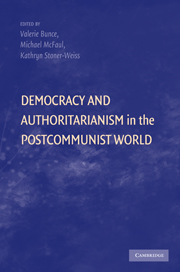Book contents
- Frontmatter
- Contents
- Prologue
- PART I WAVES OF REGIME CHANGE: FROM DICTATORSHIP TO DEMOCRACY…AND BACK?
- 1 The Missing Variable
- 2 A Regional Tradition
- PART II ENCOURAGING DEMOCRACY: THE ROLE OF THE EUROPEAN UNION
- PART III CHOOSING REGIME CHANGE: DEMOCRATIZING ELECTIONS
- PART IV RESISTING REFORM: BACKSLIDING DEMOCRACIES AND ENDURING AUTOCRACIES
- Epilogue
- Index
- References
2 - A Regional Tradition
The Diffusion of Democratic Change under Communism and Postcommunism
Published online by Cambridge University Press: 05 June 2012
- Frontmatter
- Contents
- Prologue
- PART I WAVES OF REGIME CHANGE: FROM DICTATORSHIP TO DEMOCRACY…AND BACK?
- 1 The Missing Variable
- 2 A Regional Tradition
- PART II ENCOURAGING DEMOCRACY: THE ROLE OF THE EUROPEAN UNION
- PART III CHOOSING REGIME CHANGE: DEMOCRATIZING ELECTIONS
- PART IV RESISTING REFORM: BACKSLIDING DEMOCRACIES AND ENDURING AUTOCRACIES
- Epilogue
- Index
- References
Summary
The large-scale involvement of citizens in political life, images of town squares packed with people, along with occasions of euphoria, brought back memories of November, 1989, when the communist regime in Czechoslovakia collapsed.
Martin Butora on the 1998 Slovak electionDEMOCRATIZATION AND DIFFUSION
In a recent statistical analysis of the global spread of democratic governance, Daniel Brinks and Michael Coppedge argue that a major characteristic of the Third Wave has been the intraregional diffusion of transitions from dictatorship to democracy. Thus, even when other influential factors are taken into account, democratization in one state seems to increase the probability of democratization in adjacent states. It is the clustering of democratic change in both temporal and geographical terms since the mid-1970s, therefore, that provides strong evidence for Brinks and Coppedge of cross-national diffusion dynamics at work.
This is an important finding. However, like many diffusion studies, this one suffers from a “high altitude problem.” Because the authors are relatively removed from what is happening on the ground, they leave a number of important questions about the diffusion of democracy unanswered. First, it is not clear in their study what exactly is being diffused – the idea of democracy, the precedent of removing authoritarian leaders from office, a set of common strategies for challenging authoritarian rule, or a similar ensemble of new political institutions. Second, this study is silent on the question of how the diffusion of democracy actually works, that is, how democratic changes are transferred from one place to another.
- Type
- Chapter
- Information
- Publisher: Cambridge University PressPrint publication year: 2009
References
- 2
- Cited by



